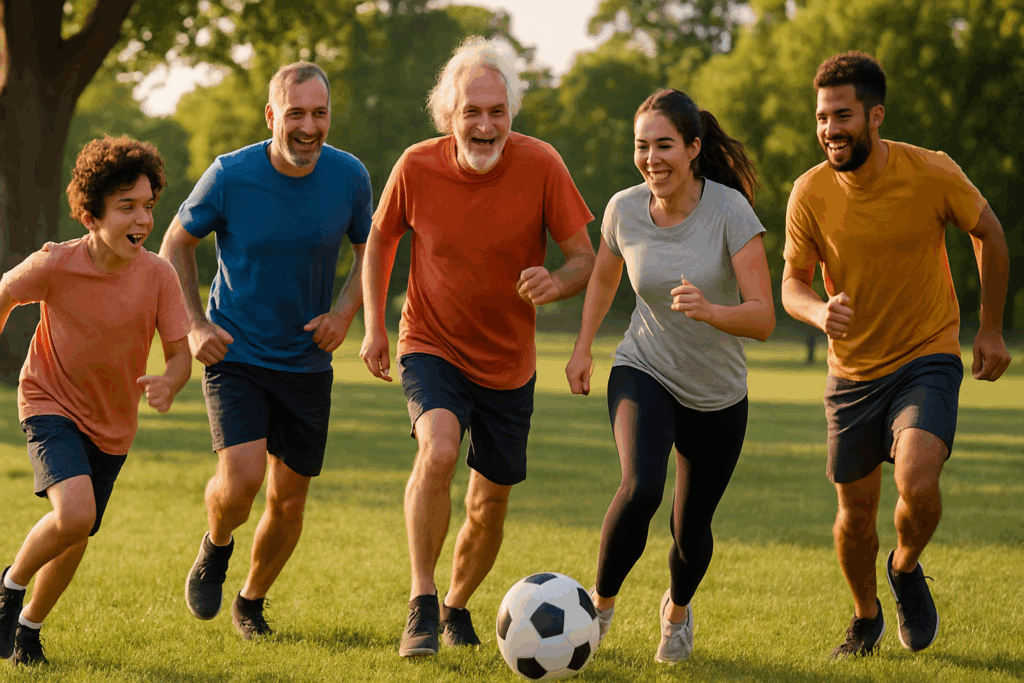Introduction: Why Fun Cardio Matters for Endurance and Performance
When it comes to building stamina and enhancing physical performance, many people imagine grueling training sessions, sweat-drenched gym floors, and endless repetition. However, endurance doesn’t have to be boring, and cardiovascular exercise doesn’t have to feel like a chore. In fact, fun cardio activities can play a vital role in improving your stamina while making your fitness journey more sustainable, enjoyable, and mentally rewarding. As the fitness industry evolves, so does the understanding that enjoyment is a powerful driver of consistency—and consistency is the bedrock of long-term endurance gains.
Integrating enjoyable, engaging aerobic exercises into your routine doesn’t just help with cardiovascular health; it also supports mental well-being, reduces stress, and enhances motivation. This article explores a range of fun cardio activities that deliver real results, all while keeping boredom at bay. Whether you’re training for a marathon, seeking to boost overall energy, or simply want to feel more vibrant throughout the day, there’s a fun cardio strategy that can align with your goals. We’ll also unpack the physiological principles behind aerobic endurance, and how joyful movement can unlock untapped potential in your performance capacity.
You may also like: How to Increase Stamina and Endurance Naturally: Smart Training Tips and Nutrition Habits That Support Cardiovascular Fitness

Understanding Cardiovascular Endurance: The Foundation of Physical Stamina
Cardiovascular endurance refers to the body’s ability to sustain prolonged physical activity by efficiently delivering oxygen to working muscles. It depends on the health and efficiency of the heart, lungs, and blood vessels, as well as the muscles’ ability to use oxygen effectively. This foundational component of fitness enables individuals to engage in various physical activities for extended periods without undue fatigue, making it a critical metric for both athletes and everyday exercisers.
Improving cardiovascular endurance brings a host of benefits that extend beyond athletic performance. These include reduced risk of chronic diseases such as heart disease, diabetes, and obesity, as well as enhanced mental clarity, emotional resilience, and energy levels. The beauty of endurance training lies in its adaptability: whether you’re dancing, cycling, hiking, or engaging in martial arts, you’re strengthening the systems that underpin cardiovascular stamina.
Traditional cardio methods like jogging and treadmill sessions certainly work, but for many, they become monotonous over time. This is where fun cardio activities come in. By incorporating enjoyable forms of movement, individuals are more likely to stick with their exercise routines, thereby reaping sustained and cumulative benefits. It’s not just about how hard you push, but how consistently you move.

The Science Behind Fun Cardio: Why Enjoyment Enhances Results
Research in exercise psychology has consistently shown that enjoyment significantly impacts adherence to physical activity routines. When cardio feels like fun, individuals are less likely to skip sessions and more likely to engage fully in the experience. This is critical because the most effective workout is not necessarily the hardest one—it’s the one you actually do regularly.
Neuroscientific studies indicate that enjoyable physical activities activate the brain’s reward system, releasing feel-good neurotransmitters such as dopamine and serotonin. This biochemical reinforcement creates a positive feedback loop, increasing the likelihood that you will return to the activity. Over time, these fun aerobic exercises can become a source of pleasure and intrinsic motivation rather than obligation.
Furthermore, psychological factors such as perceived exertion are lower during enjoyable exercise, meaning people often push themselves harder without realizing it. A dance class or a game of ultimate frisbee may elevate your heart rate as effectively as a HIIT workout, but with far less mental resistance. In this way, fun cardio provides a hidden performance advantage: it enhances both physical output and long-term commitment.

Dancing Your Way to Endurance: Joyful Movement with Big Benefits
Dance-based workouts are among the most effective and entertaining ways to improve stamina. Whether it’s Zumba, hip-hop, ballet-inspired cardio, or cultural styles like salsa or bhangra, dance routines combine rhythm, coordination, and aerobic movement into one exhilarating package. The dynamic nature of dance requires constant movement and shifting intensity, which challenges the heart and lungs while keeping the mind engaged.
One of the most appealing aspects of dance as a form of cardio is its accessibility. You don’t need a gym membership or expensive equipment—just a bit of space and music. Dance also fosters creativity and self-expression, which can be especially uplifting for mental health. Over time, regular dance sessions improve cardiovascular endurance, coordination, balance, and muscular tone, particularly in the lower body.
In structured classes or home-based formats, dance serves as both a workout and a mood booster. Because the routines are often choreographed to high-energy music, participants experience time differently. The workout feels shorter, even when it exceeds 45 minutes, due to the immersive and joyful nature of the activity. This is a prime example of how fun cardio can enhance stamina without the perception of exertion.

Game-Based Cardio: Sports, Play, and Friendly Competition
Another highly effective and engaging form of aerobic training comes from sports and game-based movement. Activities like soccer, basketball, tennis, and even recreational games like tag or capture the flag provide intense cardiovascular benefits wrapped in the thrill of play and competition. These activities demand constant motion, agility, and decision-making, all of which contribute to cardiovascular and cognitive endurance.
Unlike repetitive treadmill sessions, sports offer unpredictable scenarios that challenge your body in varied and dynamic ways. This variability prevents plateaus and encourages a broader range of muscular and neurological adaptation. Additionally, the social aspect of playing sports or group games contributes to emotional wellness and makes exercise feel like a celebration rather than a task.
For adults who miss the spontaneous play of childhood, engaging in recreational leagues or friendly pickup games can reignite that spirit of fun and movement. This is particularly valuable for maintaining long-term fitness habits, as enjoyment is a critical predictor of adherence. When fun cardio becomes a communal experience, it reinforces social bonds while boosting stamina and performance.
Cardio on the Move: Hiking, Trail Running, and Outdoor Exploration
Outdoor activities offer a rich sensory experience that elevates cardio workouts to a whole new level. Hiking, trail running, and even brisk walking through parks or nature trails combine aerobic exercise with the therapeutic benefits of nature exposure. These activities promote endurance by engaging large muscle groups over extended periods, often in varied terrain that adds resistance and complexity.
Trail running, in particular, is a potent form of fun aerobic exercise that builds leg strength, balance, and cardiovascular stamina. Unlike the flat monotony of treadmill running, trails offer constant change in elevation, surface texture, and visual stimuli. This keeps the mind engaged and the body adapting. It also reduces the risk of overuse injuries common in repetitive-motion activities.
Hiking, while often considered less intense, can be equally powerful when approached with intention. Extended hikes over hilly or mountainous terrain provide steady-state cardio, allowing for prolonged fat-burning and aerobic conditioning. The immersive experience of being in nature also reduces cortisol levels, which supports recovery and hormonal balance. When movement and environment harmonize, endurance training becomes something to look forward to.

Jumping into Cardio: Rebounding and Skipping for High-Impact Fun
Rebounding (jumping on a mini-trampoline) and skipping rope are two underappreciated but highly effective cardio options that infuse fun into aerobic training. Both are deceptively simple yet profoundly efficient in elevating heart rate, improving coordination, and enhancing muscular power.
Rebounding, in particular, has gained attention for its low-impact nature. The trampoline surface absorbs shock, reducing stress on joints while still providing high-intensity cardiovascular engagement. Studies have shown that rebounding can be as effective as running in improving VO2 max, a key indicator of aerobic fitness, while also supporting lymphatic drainage and joint health.
Skipping rope, on the other hand, offers an intense cardiovascular challenge in a compact form. It improves timing, agility, and rhythm, making it a favorite among boxers and elite athletes. But it also lends itself to playful variation—double unders, criss-crosses, and high knees turn the workout into a skill-building session. As with all fun cardio activities, the key lies in enjoyment. When you’re jumping to your favorite music or testing new patterns, the minutes fly by.
Aquatic Cardio: Swimming, Water Aerobics, and Splash-Based Fitness
Water-based exercises provide a unique cardiovascular stimulus with the added benefit of joint protection. Swimming is a full-body workout that challenges both aerobic and muscular endurance, making it ideal for those seeking high-intensity, low-impact fun cardio options. Each stroke requires rhythmic breathing, core stabilization, and coordination across multiple muscle groups.
For those less inclined to swim laps, water aerobics or aqua Zumba offer playful and community-driven alternatives. The resistance of water enhances calorie burn while minimizing the risk of injury. These classes often incorporate upbeat music, flotation equipment, and choreography, turning the pool into a dance floor and fitness space all at once.
Aquatic cardio also benefits individuals recovering from injury, older adults, or anyone managing joint pain. The buoyancy of water reduces load on the spine and limbs, allowing for more comfortable movement. Whether you’re swimming laps or splashing through a water-based boot camp, the fluid nature of aquatic fun cardio supports endurance without overtaxing the body.

Technology-Enhanced Cardio: Interactive Workouts and Gamified Fitness
Modern advancements in fitness technology have created new opportunities to transform cardio into a compelling, game-like experience. Virtual reality fitness, app-based challenges, and interactive platforms like Peloton or Zwift offer immersive environments that engage both body and mind. These tools gamify cardio, tracking progress, offering rewards, and enabling users to compete or collaborate in real time.
Gamified fitness apps often use storytelling or mission-based tasks to create a sense of adventure. For example, running apps might simulate a zombie chase, or cycling platforms may take you through virtual landscapes. These narratives shift focus from effort to experience, making workouts more engaging and emotionally resonant.
Smartwatches and heart-rate monitors further personalize the experience, offering real-time feedback and tailored goals. This fosters a sense of agency and progression, which is key to maintaining motivation. When technology makes cardio fun, accessible, and meaningful, it elevates the training experience and supports sustainable endurance building.
Frequently Asked Questions: Fun Cardio Activities for Endurance and Performance
1. How can fun cardio activities improve long-term motivation for fitness goals?
Fun cardio activities engage both the body and mind, making the workout experience something to anticipate rather than dread. By incorporating enjoyment into exercise, individuals are more likely to form consistent habits, which is crucial for long-term fitness success. Enjoyable movement creates emotional rewards that reinforce repetition, helping to reduce burnout and prevent plateaus. Many people find that fun cardio routines act as a psychological reset, especially when combined with music or a social component. Over time, these positive associations help internalize the habit, making fitness feel less like a duty and more like a lifestyle.
2. What are some lesser-known but effective fun aerobic exercises that support stamina?
Beyond mainstream options like dancing or cycling, activities such as hula hooping, trampoline workouts, and cardio drumming offer powerful endurance benefits. These fun aerobic exercises challenge coordination and rhythm while keeping the heart rate elevated for extended periods. Additionally, Nordic walking—using poles to walk with upper-body engagement—is popular in Europe and gaining traction in the U.S. as a low-impact, full-body endurance activity. Each of these approaches blends novelty and functionality, making them excellent choices for anyone seeking variety. Including a mix of these exercises can also reduce overuse injuries and improve cardiovascular resilience.
3. Can fun cardio routines replace traditional endurance training for athletes?
While fun cardio routines may not always mimic the specificity of competitive endurance sports, they can complement and sometimes enhance overall performance. For example, dance-based interval training or agility-based games can improve footwork, coordination, and aerobic capacity in runners or field athletes. These activities can also serve as active recovery, offering a break from rigid training without compromising fitness levels. Athletes often use fun cardio as a cross-training method to diversify movement patterns and reduce mental fatigue. With thoughtful integration, fun cardio activities can be a valuable supplement to a periodized training program.
4. How do social dynamics influence the success of fun cardio programs?
Social interaction plays a pivotal role in the success and longevity of fitness routines, especially those centered around fun cardio activities. Group-based classes or team sports provide accountability, encouragement, and a shared sense of purpose, all of which enhance adherence. The communal aspect transforms workouts into events, creating bonds that increase commitment. Social settings also allow for healthy competition, further driving performance and consistency. When people engage in fun cardio alongside others, the experience becomes emotionally richer and far more sustainable.
5. Are there specific fun cardio activities that cater to different personality types?
Absolutely—the variety of fun cardio options available today means there’s something to suit every disposition. Extroverted individuals might gravitate toward Zumba or group kickboxing, where high energy and social engagement are key. Introverts may prefer solo activities like trail running, cycling, or rhythm-based online fitness platforms that offer immersive but private experiences. Analytical types may enjoy gamified fitness apps with metrics and goals, while creative minds might find inspiration in dance improvisation or choreography-based classes. Matching fun cardio routines to personality traits can improve emotional satisfaction and boost long-term participation.
6. How can fun aerobic exercises be adapted for people with mobility limitations?
Fun aerobic exercises can be easily modified for various physical abilities by adjusting movement intensity, duration, or body positioning. Seated cardio routines, aqua aerobics, or adaptive dance classes allow those with mobility limitations to enjoy the benefits of cardiovascular activity. Technology has also enabled virtual reality-based programs and motion-tracking systems that cater to different mobility levels. Incorporating props such as resistance bands or light hand weights can enhance engagement and muscular activation without strain. The core idea is to maintain movement patterns that elevate heart rate while providing joy and accessibility.
7. What are the cognitive benefits associated with fun cardio activities?
Engaging in fun cardio activities offers more than just physical perks—they can also sharpen cognitive function. The mental stimulation involved in learning dance routines or reacting in team sports improves memory, spatial awareness, and decision-making. Cardiovascular exercise in general boosts cerebral blood flow, but fun aerobic exercises specifically tend to promote neuroplasticity due to their complex and novel nature. These workouts stimulate both hemispheres of the brain, which is particularly valuable for aging populations aiming to maintain mental agility. Over time, the combination of physical and mental challenge builds resilience across both domains.
8. Are there cultural or lifestyle trends influencing the rise in fun cardio programs?
There has been a noticeable cultural shift toward movement that feels intuitive, joyful, and expressive. From viral dance workouts on social media to immersive fitness apps and boutique studios offering fusion classes, fun cardio has become a lifestyle trend. People are moving away from rigid, prescriptive fitness norms and embracing routines that align with their personal values, creativity, and schedules. The growing emphasis on mental health and work-life balance has also fueled interest in exercise formats that relieve stress and uplift mood. As wellness becomes more holistic, fun aerobic exercises are gaining mainstream legitimacy.
9. What are the best strategies for measuring progress with fun cardio workouts?
Tracking progress with fun cardio requires a more holistic approach than simply counting reps or measuring distance. Heart rate variability, perceived exertion, and duration consistency are all valuable metrics for evaluating endurance improvement. Using wearable fitness trackers can offer data on calories burned, time in target heart rate zones, and weekly movement trends. Psychological markers such as mood enhancement, sleep quality, and reduced fatigue are equally important. Since fun cardio routines are diverse, progress should be assessed both quantitatively and qualitatively for a complete picture of gains.
10. How can someone build a sustainable routine around fun cardio if they have a busy schedule?
Even the busiest individuals can integrate fun cardio into their lives by reframing movement as play rather than obligation. Ten-minute dance breaks between meetings, brisk walks during calls, or weekend social sports games are simple yet effective ways to incorporate aerobic activity. Prioritizing short, high-intensity fun cardio sessions can also yield endurance benefits without requiring large time commitments. Scheduling workouts that align with personal interests or daily rhythms makes it easier to follow through. The key is consistency and choosing fun aerobic exercises that feel more like self-care than sacrifice.
Conclusion: Embracing Fun Cardio for Lasting Endurance and Peak Performance
In a world where busy schedules and mental fatigue often stand between people and their health goals, fun cardio activities provide a refreshing path toward sustainable fitness. By making movement enjoyable, we reduce the psychological barriers that often undermine consistency and motivation. This approach is not only more pleasurable but also more effective in the long run, as it fosters the kind of commitment necessary for genuine endurance development and performance enhancement.
Whether you find your rhythm on the dance floor, the trail, the court, or in the pool, each joyful step, jump, or glide contributes to a stronger heart, more resilient body, and clearer mind. The physiological benefits of fun aerobic exercises are profound, but perhaps their most valuable feature is the way they transform obligation into inspiration. When cardio becomes something you look forward to, rather than something you have to do, it changes the entire equation of fitness.
By embracing a diversity of enjoyable activities that support cardiovascular health, you build not only physical stamina but also emotional resilience and long-term wellness. As you explore these fun cardio options, let curiosity guide you, and remember that the best form of exercise is the one you can’t wait to do again tomorrow. In the pursuit of better performance and enduring energy, joy may just be your most powerful ally.
Was this article helpful? Don’t let it stop with you. Share it right now with someone who needs to see it—whether it’s a friend, a colleague, or your whole network. And if staying ahead on this topic matters to you, subscribe to this publication for the most up-to-date information. You’ll get the latest insights delivered straight to you—no searching, no missing out.
Further Reading:
3 Kinds of Exercise That Boost Heart Health

